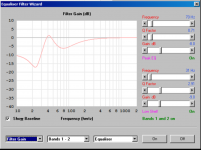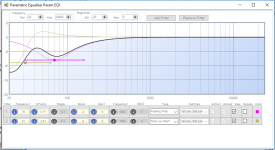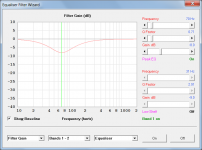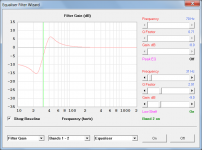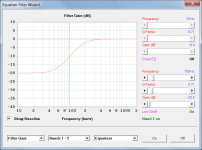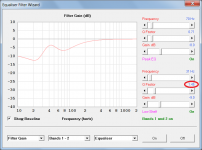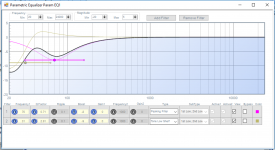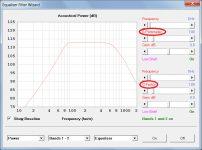I used the same numbers in horn response and in sigma studio to optimize the low end for a super low budget speaker system I am working on for the 'silk purse' contest in the multi-way forum. Unfortunately I see very wildly different graphs of what is going on. I have attached screenshots of both.
Did I screw something obvious up? Which one seems more correct? Unsure how to model this as the whole point of this was to keep it at xmax and if the sim is wildly off then maybe I should just say screw it and go by REW measurements entirely, ignore xmax entirely, and just keep an eye on distortion?
Did I screw something obvious up? Which one seems more correct? Unsure how to model this as the whole point of this was to keep it at xmax and if the sim is wildly off then maybe I should just say screw it and go by REW measurements entirely, ignore xmax entirely, and just keep an eye on distortion?
Attachments
Unfortunately I see very wildly different graphs of what is going on.
Hi Jared,
It is interesting that there should be such a difference. Have you tried comparing each of the equaliser gains separately? I suspect that the low shelf responses may not be the same. The sanity check Hornresp low shelf response shown in the third attachment seems about right, although I must confess that I am no expert when it comes to electronic filters
Kind regards,
David
EDIT - Looking more closely at your Sigma Studio chart, I can see now that the low shelf gain is indeed different to that of Hornresp.
Attachments
Last edited:
I did not put -20 into hornresp, I put -9 in ?
Hi Jared,
The -20 dB test example I included was simply to show more clearly that the Hornresp result for a low shelving filter was as one would expect. It seems that the Sigma Studio Q Factor values for shelf filters are calibrated differently to those in Hornresp, and to match the results you need to either halve the Hornresp value or double the Sigma Studio value. For example, if you change your Sigma Studio Q value from 2.91 to 5. 82, or your Hornresp value from 2.91 to 1.45, you will see that the results become the same.
I have no idea why the Sigma Studio shelf filter Q calibrations should be different to those used in Hornresp
Would it be possible for you to post a screenprint of a Sigma Studio low shelf filter chart with Frequency = 100 Hz, Q Factor = 1 and Boost = -20 dB? Thanks.
Kind regards,
David
Attachments
Hi Jared,
I did some more investigating. It turns out that the Sigma Studio "Q Factor" is actually S, a "shelf slope" parameter.
The relationship between Q and S is given by the expression:
S = 1/((((1/Q)^2-2)/((10^(G/40))+1/(10^(G/40))))+1)
Where:
S = shelf slope parameter
Q = Q factor
G = gain
A setting of 2.91 for "Q factor" in Sigma Studio is actually a setting of 2.91 for S. From the above equation, when the gain is -9 dB, the equivalent value of Q works out to be 1.403, which is the value that needs to be entered into Hornresp (rounded to 2 decimal places) for the results to match.
The Sigma Studio labeling is very confusing indeed. Rest assured, the Hornresp filter response results are correct .
.
Kind regards,
David
I did some more investigating. It turns out that the Sigma Studio "Q Factor" is actually S, a "shelf slope" parameter.
The relationship between Q and S is given by the expression:
S = 1/((((1/Q)^2-2)/((10^(G/40))+1/(10^(G/40))))+1)
Where:
S = shelf slope parameter
Q = Q factor
G = gain
A setting of 2.91 for "Q factor" in Sigma Studio is actually a setting of 2.91 for S. From the above equation, when the gain is -9 dB, the equivalent value of Q works out to be 1.403, which is the value that needs to be entered into Hornresp (rounded to 2 decimal places) for the results to match.
The Sigma Studio labeling is very confusing indeed. Rest assured, the Hornresp filter response results are correct
Kind regards,
David
...The relationship between Q and S is...
Hi David, do you have a link or reference for this?
I see a shelf filter as a cluster of one or more poles, associated with a cluster of the same number of zeros, the pole or zero cluster lower in frequency dependent on which way it shelves.
So I don't see what "the" Q of a shelf filter means, presumably there are conventions, maybe there's a canonical audio shelf filter.
Some kind of shelf slope parameter does makes sense to me but I have no idea if there is a standard way to express it.
Just started to think seriously about EQ for my horn system so thanks for the post, made me realize I had never really considered this question.
Best wishes
David Zan
Last edited:
It is described in http://www.musicdsp.org/files/Audio-EQ-Cookbook.txt
Thank you, so it's assumed only 2 poles & 2 zeros - a biquad.
I'll have a closer look.
Best wishes
David
Compliments on the latest polar analysis interface, by the way.
I'll have a closer look.
It still is not clear to me.
Even if we limit the shelf filter just to a biquad there are still two Q's, one for the zeros and one for the poles.
Does Hornresp further limit the biquad and assume the same Q for both?
Best wishes
David
thanksCompliments on the latest polar analysis interface, by the way.
FWIW I don't think I've ever seen a definition of a shelf filter that has 2 Qs, have you come across one?Does Hornresp further limit the biquad and assume the same Q for both?
FWIW I don't think I've ever seen a definition of a shelf filter that has 2 Qs, have you come across one?
As I commented, I haven't previously really considered it, in fact not actually seen any definition, have you a link to one?
There are two independent Qs in the maths.
I assume that it is common to make Qs identical of simplicity and then refer to "the" Q.
Not sure if that is convention only, perhaps a consequence of a convenient implementation in the pre-DSP era, hence my query.
The difference between...virtually every other ...
Which others, all software?
Best wishes
David
Last edited:
Hi David, do you have a link or reference for this?
Hi David,
The formula is given in Section 4.1 (titled "Q or S").
Parametric Equalizer - JRiverWiki
Kind regards,
David
FWIW I wrote that page on the jriver wiki as it's the only software I've come across that uses S but describes it as a Q. The formula is just a rearrangement of that given in the audio cookbook btw.
what sort of definition do you mean? a strict mathematical one or something that describes the transfer function in words?As I commented, I haven't previously really considered it, in fact not actually seen any definition, have you a link to one?
jriver is the only software I've seen that uses S, examples that spring to mind that use Q are rephase, acourate & minidsp.Which others, all software?
The formula...
Parametric Equalizer - JRiverWiki
Thanks, I'll read it
...what sort of definition do you mean?
Whatever sort you meant when you asked me if I'd come across one.
Seriously, either would do, I just want to avoid the sort of confusion that mislead the OP.
Maybe more questions for the author after I read the link.
Best wishes
David
now you mention I don't think I've ever seen a specific but readable definition of the transfer function of a shelf filter, the cookbook describes the slope as being in proportion to S (for values up to 1) without saying what that means exactly. I was curious so I calculated a few values and it seems that each +1 in S increases the slope around the centre frequency by 6dB (so S=1 is 6dB/octave, S=2 is 12dB/octave and so on) with the overshoot at either end getting progressively worse as you go beyond S=1.Seriously, either would do, I just want to avoid the sort of confusion that mislead the OP.
now you mention I don't think I've ever seen a specific but readable definition of the transfer function of a shelf filter...
I looked at the plots and it looks like the assumptions are
1. A biquad filter
2. Q of zeroes = Q of poles.
That's what I suspected but I haven't confirmed it from the calculations of the coefficients yet, it seems reasonable however.
Best wishes
David
Last edited:
Which others, all software?
Best wishes
David
Maybe im exaggerating, but both versions of LspCAD and TIs DSP configurator (from what I remember) are both different from sigma.
both versions of LspCAD and TIs DSP...
Sorry, I wasn't very clear, I didn't mean "all software" does this?
I meant "all" [the ones that do this are] "software"?
I wasn't sure if it was a carry-over from a convenient analog implementation, or a software choice.
I now suspect that it's because everyone has simply copied Robert Bristow-Johnson's work.
Best wishes
David
It turns out that the Sigma Studio "Q Factor" is actually S, a "shelf slope" parameter.
If all goes according to plan, the next release of Hornresp will enable the user to input either "Q Factor" or "S Parameter" shelving filter values.
Attachments
- Status
- This old topic is closed. If you want to reopen this topic, contact a moderator using the "Report Post" button.
- Home
- Design & Build
- Software Tools
- HornResp vs Sigma Studio
